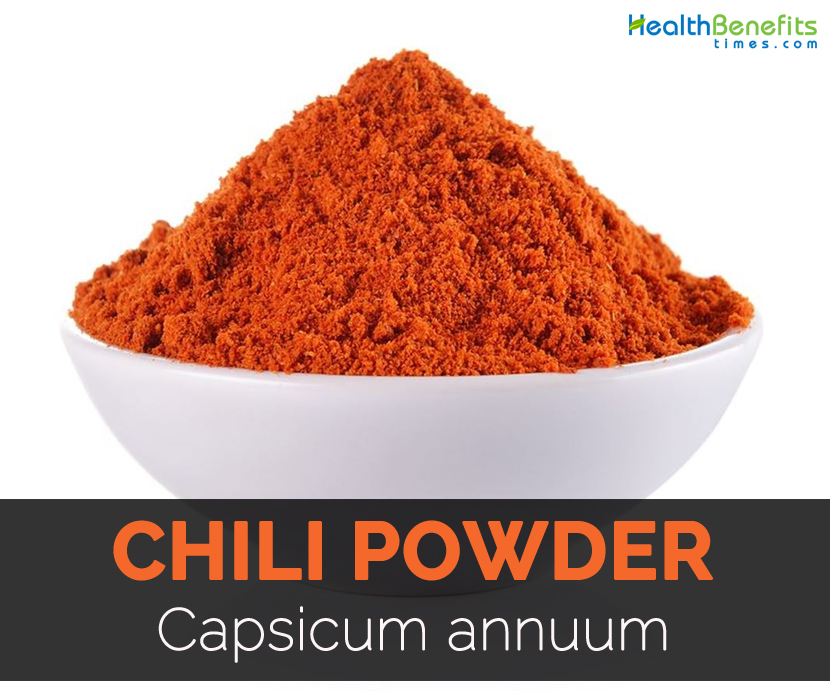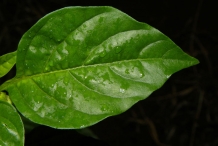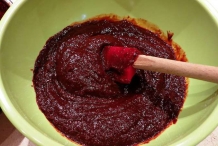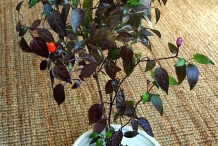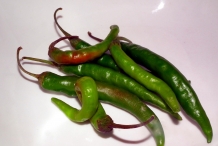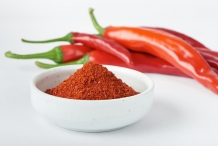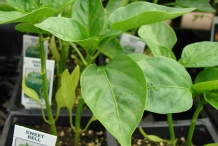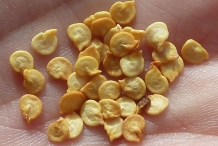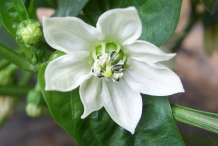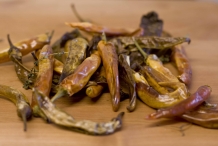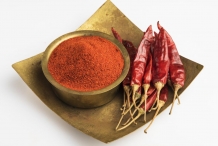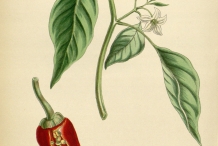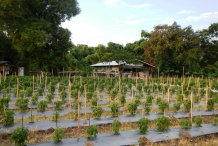The perennial plant Capsicum annuum is now cultivated as annual in temperate climates. The plant is many branched which grows upto 75 cm in cultivated varieties and founds to be shrubby in appearance. Leaves are alternate, simple, elliptical to lanceolate having entire and smooth margins. Flowers are small which reborne singly or rarely in pairs in the axils. It is white but occasionally found to be purple and in bell shaped with 5 lobes and contains five bluish stamens. Fruits are pod which varies in shape and size that ripens to yellow, green, red, orange and purple.
Various varies are developed and is categorized in five major groups: Cerasiforme, Conoides, Fasciculatum , Grossum and Longum. The varieties include well-known Mexican peppers such as serranos, jalapenos and poblanos. Some varieties of pepper are known as cayenne and chili peppers which is closely related species C. frutescens including Tabasco varieties used in Tabasco sauce and Habanero peppers.
Peppers are used cooked, fresh and fried in enormous variety of dishes characteristic of various regional cuisines. It is rich in Vitamin C and A. Some varieties are used as ornamental for indoor pots and it often possess small and brightly colored persistent fruits.
Capsaicin is obtain from C.annuum and Capsicum species which is an intense skin and eye irritant and is used as an ingredient for pepper sprays which is sold for self-defense. It is used for various medicinal uses such as provides topical pain relief for muscle soreness, skin irritations, shingles and rheumatism. It is also used as an anti-inflammatory. The medicinal research has shown antifungal and antimicrobial activity.
Though known as pepper (Capsicum annum), it is not closely associated with spice known as black pepper (Piper nigrum) which was a prominent spice trade of Middle Ages. Chili pepper contains capsaicin which is a bioactive plant compound that is responsible for being spicy and hot.
Plant
Capsicum annum is a small, branched and mostly erect, annual or perennial herbaceous shrub that grows 30 to 80 cm tall with short or deep taproot. Stems are glabrescent. It has solitary or paired, alternate leaves having 4 to 7 cm petiole. Leaf blades are ovate, oblong to ovate or ovatelanceolate measuring 4-13 × 1.5-4 cm. It has narrowed base, wavy and entire margin with acute or short acuminate apex. The inflorescences are solitary flowers which form in 1 to 2 clusters. Pedicel is 1 to 2 cm which is bent at apex. Flowers are pendent, off-white and small. Calyx is campanulate and is 2–3 × 3 mm. Corolla is five-lobed white measuring 10 mm. Anthers are bluish/purplish and is about 1.8 to 2 mm. Fruit is a berry with firm and fleshy pericarp. When mature, it measures 15 cm. In most commercial cultivates, color changes from green to red, green to yellow and green to orange. The purple and white varieties fruits possess this color as they develop. Seeds are pale yellow measuring 3 to 5 cm across and are discoid or reniform.
History
The chilli peppers are used for making chili powder and have been used as the part of diet since 7500 BC. In S. America, it was the first cultivated crop and since then has been used in many dishes. The first European was Christopher Columbus to contact them and gave it the name pepper due to its spicy and hot taste. It is also used for its medicinal effects and cures various conditions that were documented firstly in 1494.
Firstly chili was used in South and Latin American countries and got quickly spread due to trade and made its way in Indonesian, Chinese, Asian and Korean cultures. The intensity of these peppers varies that depends on where the chili is cultivated. When the chilies are made in the powder form, it becomes even stronger and hotter in intensity due to the fact that seeds are used are the hottest part of pepper, it is used to make powders in different cuisines.
Medicinal uses
- Alleviate Joint Pain
It provides relief from joint pain. It also promotes the flow of blood.
Requirements:
- 12 Fresh chili peppers
- 3 cups of cold-pressed olive oil
- 1 Glass jar
Directions:
- Grind 12 fresh chili peppers and put it in a glass jar.
- Pour 3 cups of cold-pressed olive oil into the glass jar.
- Store it in a cool place and away from direct sunlight.
- Let it remain for 7 days.
- Then strain the preparation and let the oil remain.
- Use this oil to rub at the sites of having joint pains.
- Repeat it for many times in a day.
- Soreness of Throat
Requirements:
- 1 teaspoon of dried chili powder
- 1 glass warm water
Directions:
- Take 1 glass of warm water (not too hot) and 1 tsp. of dried chili powder.
- Add chili powder in the water.
- Mix it thoroughly.
- Gargle with this liquid for about 10 minutes.
- Flatulence and Gas
Requirements:
- 1 tsp. of Chili pepper powder
- ½ tsp. of Cumin seed powder
- ½ tsp. of Black salt
- 1 glass warm water
Directions:
- Combine 1 tsp. of chili pepper powder, ½ tsp. each cumin seed powder and black salt. Mix it well.
- Add this mixture to one glass of warm water.
- Mix it thoroughly.
- Then consume the liquid directly.
- Repeat it regularly.
- Treatment for Nausea
Requirements:
Directions:
- Grind 1 chili pepper into a paste.
- Then add 1 tsp of camphor and 3 tsp lime juice to this paste.
- Combine it well.
- Consume 1 teaspoon of this preparation to get relief from nausea.
- Relieves Toothache
Requirement:
- ½ teaspoon of Chili pepper powder
- ½ teaspoon of Clove oil
Directions:
- Mix ½ tsp. each of chili pepper powder and clove oil. Mix it properly.
- Put this mixture on the tooth having pain.
- Leave it for about 45 minutes.
- Then wash your mouth with cool water.
- Repeat it two times a day.
- Use it until you get relief from toothache.
- Cure for cough
Requirements:
- 2 Chili peppers
Directions:
- Grind 2 chili peppers into powder.
- Now add it to meal.
- Repeat it with every meal.
- Sore throat
Ingredients:
- 2 teaspoon of Chili pepper powder
- 1 cup of Orange juice
Directions:
- Add 2 tsp. of chili pepper powder to 1 cup of orange juice. Mix it properly.
- Drink the liquid directly.
- Use it for two times in a day regularly.
- Common cold and cough
Requirements:
- 1 tsp. of Chili powder
- 1 tbsp. of Apple cider vinegar
- 1 tbsp. Coconut oil
- 1 tsp. Lemon juice
- 1 tbsp. Honey
- 1 cup Pineapple juice
Directions:
- Take 1 tsp. of chili powder, 1 tsp. of lemon juice, a cup of pineapple juice, 1 tbsp coconut oil and1 tbsp. of apple cider vinegar. Combine all the ingredients.
- Take 2 tbsp. of this preparation four times regularly.
- Use it till you provide a total relief.
- Recover diarrhea
Requirements:
- 1 tbsp. of Chili pepper powder
- ½ cup curry leaves
- 1 tsp. tamarind
- ½ tsp. salt
- ½ bowl hot rice
Directions:
- Combine 1 tbsp. of chili pepper powder, ½ cup of curry leaves, 1 tsp. of tamarind and ½ tsp. salt together.
- Add a little water to the mixture and grind it a paste.
- Put the paste in ½ bowl of rice. Mix well.
- Now directly consume the rice.
Traditional uses
- Use it internally for debility, cold stage of fevers, asthma, varicose and upset stomach.
- Use it externally for sprains, unbroken chilblains, neuralgia and pleurisy.
- In Korea, fruit is used to smooth blocked internal organs, warm body coldness, treat emesis, and activate stomach function, scabies, stomach ache and dysentery.
- Stem is used to treat rheumatic psychroalgia.
- Leaves are useful for emesis, dysentery and scabies.
- In Peninsular Malaysia, the root decoction is used to treat gonorrhea.
- It provides relief from muscle soreness, shingles, skin irritations and rheumatism.
Precautions
- The pepper spray causes runny nose, breathing difficulties, temporary blindness and pain in eyes.
- Sensitive individuals should use face masks and thin hand gloves while handling chilies.
- Consume yogurt to lower the burning pain.
- Avoid touching eyes with chili contaminated fingers. Rinse eyes with cold water to lower irritation.
- It may worsen gastroesophageal reflux condition.
- Spoiled chilies contain chemical compounds such as aflatoxin which causes liver, stomach and colon cancer.
How to Eat
- Fruits are consumed cooked or raw and is also dried, frozen, canned and pickled.
- The fruits are processed as salsas, powders, coloring agents and sauces.
- The seed oil is used for flavoring and seasoning.
- The chili powder is used as a vital ingredient for curries.
- Leaves and flowers are added to stews and soups and also consumed as potherb in Southeast Asia.
- It could be added to pickles, vegetables, pasta, meat, stews, salads, sandwiches, marinades, sauces, eggs and stir fries.
- The chili powder could be blended with onion, cumin, salt and garlic powder.
- Add chili peppers to healthy sautéed vegetables to add up the spice.
- The minced chili peppers could be added to yogurt and used as a dip or condiment.
- Jalapenos could be added to tuna salad recipe.
- It is used as a spice mix.
- Hot chilies are used as a condiment for preparing soups, chili oil, chili sauce, vinegar spice mix and spicy water.
- In South Indian states, chilies soaked in yogurt and dried under sunlight and consumed as a condiment side dish which is served during dinner time.
Other Facts
- Chili is cultivated for thousands of years.
- Above 400 varieties are cultivated in China, Japan, Indonesia, Thailand and Mexico.
- The commonly used Chilis are serrano, jalapeno, yellow wax, poblano, habanero, birds eye and cayenne.
- The heat of chili is rated in Scoville units or parts per million capsaician.
- The largest producer of chilly is India.
References:
https://www.itis.gov/servlet/SingleRpt/SingleRpt?search_topic=TSN&search_value=30492#null
http://www.herbgarden.co.za/mountainherb/herbinfo.php?id=424
https://en.wikipedia.org/wiki/Chili_powder
https://www.1800remedies.com/health-benefits-uses-chili-peppers/
http://blog.americanspice.com/fun-facts-on-chilis/
http://www.chilly.in/chili_facts.htm
https://www.nutrition-and-you.com/chili-peppers.html
Comments
| Chili Powder Quick Facts | |
|---|---|
| Name: | Chili Powder |
| Scientific Name: | Capsicum annuum |
| Origin | It has its center of diversity in Mexico and northern Latin America. It has been introduced all over the world and is grown extensively as a spice and medicine. |
| Colors | It has its center of diversity in Mexico and northern Latin America. It has been introduced all over the world and is grown extensively as a spice and medicine. Presently, it could also be found in tropical and temperate areas around the world. |
| Shapes | Up to 15 cm |
| Taste | Spicy |
| Calories | 23 Kcal./cup |
| Major nutrients | Vitamin E (20.33%) Iron (17.25%) Vitamin A (17.00%) Sodium (15.27%) Vitamin B6 (12.92%) |
| Name | Chili Powder |
|---|---|
| Scientific Name | Capsicum annuum |
| Native | It has its center of diversity in Mexico and northern Latin America. It has been introduced all over the world and is grown extensively as a spice and medicine. Presently, it could also be found in tropical and temperate areas around the world. |
| Common/English Name | African Pepper, Capsicum Pepper, Bell Pepper, Cayenne, Cayenne Pepper, Chili, Cherry Pepper, Chili Pepper, Chilly Pepper, Chilli, Chitlepin, Cone Pepper, Christmas Pepper, Green Capsicum, Green Pepper, Hungarian Pepper, Halapenos, Jalapeno Pepper, Long Pepper, Numex, Mississippi Sport Pepper, Ornamental Pepper, Paprika, Pod Pepper, Pimento Pepper, Red Cone Pepper, Sweet Pepper, Red Pepper, Wrinkled Pepper |
| Name in Other Languages | Afrikaans: Rissie, Soetrissie; Albanian: Specë, Speci; Amharic: Yafranj Karya, k’arīye yefereniji (ቃሪየ የፈረንጅ), qaa-ri-ya ya-fa-ra-ne-je; Arabic: Fulful Baladî, Fulful Halou, Fulful Ahhmar, Fulai fi lah Halwa, falfuli huluw (فلفل حلو), falyflat hulwa (فليفلة حلوة), فُلْفُل حَلُو ; Armenian: Garmir Bghbegh, Karmir Pghpegh (Կարմիր Պղպեղ), Karmir Pġpeġ; Azeri: İstiot, Qırmızı Bibər; Azerbaijani: Gyrmyzy bibär, Istiot, Qırmızı bibər, İstiot, Гырмызы бибәр, Истиот; Austria: Paprika; Basque: Piperrautsa; Brazil: Pimenta, Pimentão; Breton: Pimant Dous; Belgium: Peper; Bulgarian: Cherven Piper, Piperka, Červen piper, Пиперка, Червен пипер; Catalan: Pebrotera; Chinese: Chiao-Tzu, Dàng Lùhng Jìu, Ch’ing Chiao, Hai-Chiao, Hai-Jiao, Jiao-Zi, La Jiao, La Chiao, Qing Jiao, Tian Jiao, Tìhm Jìu, Làjiāo (辣椒); Croatian: Paprika, Piperka; Czech: Paprika, Paprika Roční, Paprika-Koření, Paprika Seta, Prášková Paprika, Sladká; Danish: Chilipeber, Peberfrugt, Paprika, Sød Peberspansk Peber; Dutch: Spaanse Peper, Paprika, Spaanse Peper Soort; Egypt: Felfel Achdar, Fil fi le Achdar; Esperanto: Paprika, Unujara Kapsiko; Estonian: Harilik Parika, Punapipar; Farsi: Paprika; Fijian: Mboro, mboro nganga, mboro ni vavalangi, rokete; Finnish: Ruokapaprika, Paprika, Vihannespaprika; French: Piment Annuel, Piment Doux, Gros Piment, Paprika De Hongrie, Piment De Cayenne, Piment, Piment Des Jardins, Piment Doux, Piment Ornamental, Piment Doux D’espagne, Piment Rouge, Poivron Doux, Poivre De Cayenne, Poivre D’espagne, Poivre De Guienee, Poivron; Galician: Pementón; Georgian: Bulgaruli (ბულგარული); German: Cayennepfeffer, Chili, Chile, Chilie, Chilli, Chillie, Einjähriger Schotenpfeffer, Gewürzpaprik Paprika, Gemüsepaprika, Indischer Pfeffer, Paprika, Peperoni, Paprika-Schote, Pepperoni, Pfefferoni, Roter Piment, Pfefferschoten, Spanischer Pfeffer, Türkischer Pfeffer, Zier-Paprika; Greek: Piperia, Pipera, Piperies; Hebrew: Pilpel, Pilpelet Hagina, פפריקה מתוקה; Hungarian: Bell Paprika, Édes Paprika, Csemegepaprika, Étkezési Paprika, Jalapeño, Fűszerpaprika, Paprika, Közönséges Paprika, Piros Paprika, Termesztett Paprika, Új-Mexikói Paprika; Icelandic: Paprikuduft; India:- Gujarati: Molar, Hindu: Degi Mirch, Desi Mirch, Deshi Mirch, Hara Mirch, Mithi Mirch, Shimlaa Mirch, Kannada: Hasimenasina Kayi (ಹಸಿಮೆಣಸಿನ ಕಾಯಿ), Urdu: Degi Mirch, Shimlaa Mirch; Indonesia: Cabai, Cabe Manis, Cabe, Cabai Manis, Lombok; Iraq: Fil fi l, Fûlfûl; Italian: Peperone, Pepperoncino, Pepperoncini, Pimento; Japanese: Banshō, Papurika (パプリカ), Bansho (バンショウ), Peppaa, Tougarashi; Kazakh: Burış, Qızıl Burış (Қызыл бұрыш); Korean: pa-peu-ri-ka, pi-mang, Namcho, Papurika, Pimang (피망), papeulika (파프리카); Laos: Mak Pet Nyai, Mak Pet Wan; Latvian: Dārzeņpipari, Paprika; Lebanese: Felfel Lelece; Lithuanian: Paprika; Macedonia: Piper, Piperka; Malaysia: Cabai, Chili, Cili, Chili Manis, Cili Manis Lada; Maldive Islands : Rihamirus ( Dhivehi ); Maltese: Bżar Ikkulurit, Bżar Ħelu; Nepal: Bhede Khursani, Khursaanii; Norwegian: Spankspepper, Paprika, Søtpepper; Papiamento: Promenton, Promèntòn; Philippines:- Bikol: Sili, Bontok: Kalubengan Kalubsengan, Iloko: Sili, Tagalog: Sile, Sileng-Haba, Sili, Sileng Mahahaba Siling Pangsigang; Polish: Papryka Roczna, Papryka, Pieprzowiec Roczny; Portuguese: Pimentão, Colorau, Pimentão Doce, Pimento, Pimento De Caiena, Pimentos, Pimento Doce; Quechuan: Uchu; Romanian: Ardei, Ardei Gras, Boia De Ardei, Ardei Dulce, Boia Dulce Russian: Perets Krasnyj, Perets Zelënyi; Serbian: Paprika, Crvena Paprika; Slovašcina: Paprika, Sorta, Začimbna Mleta Paprika; Slovencina: Paprika, Paprika Sladká, Paprika Ročná, Paprika Štiplavá; Spanish: Ají, Chile Jalapeño, Chile, Guindilla, Hocico De Buey, Paprika, Pasilla, Pimienta, Pebrotera, Pimiento, Pimiento Dulce, Pimiento Morrón, Poblano, Pimentón, Serrano; Swahili: Mpilipili, Mpilipili Hoho; Swedish: Peppar, Paprika, Spanskpeppar; Swiss: Poivre D’espagne; Tajik: Qalamfur; Thai: Prik Yuak, Prik luean; Tigrinya: Gwie, Gue, Peperoni; Turkish: Biber, Pul Biber, Kırmızı Biber, Türk Biberi; Uzbek: Qalampir; Vietnamese: Of Tau, Ot, Cat At; Yiddish: Paprike, Zis Feferl; Netherlands: spaanse Peper |
| Plant Growth Habit | Perennial herbaceous plant |
| Soil | Well structured, well-drained, friable, sandy loam |
| Plant Size | 30 to 80 cm tall |
| Root | Short or deep tap root |
| Stem | Glabrescent |
| Leaves | Alternate, elliptical to lanceolate, 2.5 to 10 cm long |
| Flowering Season | May to August |
| Flower | Solitary, white to greenish or bluish-white, 1.5 cm in diameter |
| Fruit shape & size | Up to 15 cm |
| Fruit color | Green to mostly red orange, yellow, white |
| Seed | Pale yellow, discoid or reniform, 3 to 5 mm across |
| Fruit Season | July to November |
| Major Nutritions | Vitamin E (alpha-tocopherol) 3.05 mg (20.33%) Iron, Fe 1.38 mg (17.25%) Vitamin A, RAE 119 µg (17.00%) Sodium, Na 229 mg (15.27%) Vitamin B6 (Pyridoxine) 0.168 mg (12.92%) Copper, Cu 0.08 mg (8.89%) Total dietary Fiber 2.8 g (7.37%) Vitamin K (phylloquinone) 8.5 µg (7.08%) Manganese, Mn 0.136 mg (5.91%) Vitamin B3 (Niacin) 0.928 mg (5.80%) |
| Calories in 1 tbsp. (8 gm) | 23 Kcal. |


